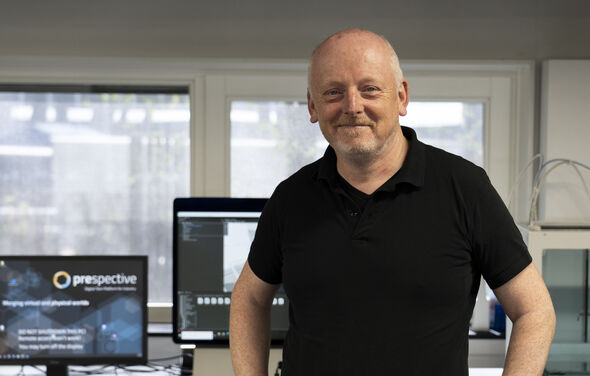“Eventually the whole campus will turn into a Digital Twin”
By making real-time digital copies of machines, cities or even human bodies, researchers intend to understand the physical world better. These live replicas of physical processes are also called Digital Twins and, thanks to increasing availability of data and new developments, are becoming more and more accurate every day. Because of the increasing importance of Digital Twinning, today’s Holst Symposium is dedicated to the concept. Among others, TU/e’s Digital Twin Lab will present several demos at the event.
What started as a group of researchers from different departments getting together to share knowledge about Digital Twins, turned into a campus-wide lab. After being founded in the Gaslab building more than a year ago, the lab recently moved to a new home in the Meulensteen House of Robotics. There it gained much needed extra space, says EAISI Program Board Director Shane Ó Seasnáin. More than seventy researchers are forming part of the Digital Twin community. “The lab is a place where they come together to share ideas and spark creativity. People of different backgrounds can learn from each other here.” The lab also facilitates research and education with knowledge and equipment.
How the Digital Twins take shape can differ a lot per research, says Ó Seasnáin. “People often think that a Digital Twin is a digital visual representation of something, but in practice what you see is not just a simple 3D model. We also bring other types of scientific knowledge into the digital world.” For example, think of a car that performs well in the Netherlands. By using a Digital Twin you can place that car in Spain or Norway, to see how it performs in other climates, the director explains. Another example: in a Digital Twin of a building, you don’t just include the building itself, but also information about where the lights and air-conditioning are turned on, or where people are in the building.
Knowledge graph
Digital Twins allow researchers to place objects in different settings or to access areas that in the physical world aren’t accessible, like human hearts. They can also combine information of an organization in a knowledge graph with the digital model. “If in a hospital a patient has a particular problem, a doctor can use such a graph to look up the last 10 patients with the same problem and see what other doctors did to treat it and how that went. In the real world you’d have to talk to all the people involved, in the virtual world you can have it all on demand.”
Both the virtual and the physical world have their own strengths and weaknesses, Ó Seasnáin says. That’s exactly why Digital Twins work so well: the physical and digital world complement each other. The physical is always more accurate, but the digital gives an insight in how the physical world works by uncovering processes that are not visible in the real world. The digital world also offers a safe environment to test things in, without expensive materials or even lives going to waste, like with animal testing.
Alternative
“I haven’t come across any cases in which Digital Twins were used as an alternative to animal testing, but I can say with a hundred percent certainty that it’s possible. Also as an alternative to human testing.” Would he trust a medicine that’s only tested with a Digital Twin, though? “That’s the challenge. If you can give a higher degree of certainty, by making the model as complete as possible, it can be trusted. They also used Digital Twins for developing the corona vaccines. That made it possible to produce the vaccines as fast as they did.”
To make Digital Twins more accurate and more useful, more data and more research is needed, Ó Seasnáin says. He sees the campus as a perfect playground for that. “We already have a Digital Twin of the Atlas building and we want to do the same for the whole campus. In general, the whole campus will turn into a Digital Twin Lab at some point”, the director says. “What I mean by that is that you will see the benefits and potentials of having Digital Twins. I’d like to see self-driving cars and drones moving around campus. You want people to get the sense that the campus is a high tech place.”
Symposium
Today the lab gets to showcase the Digital Twin of the Atlas building at the Holst symposium. “We can show people how energy is used in the building and what we can do to make that more efficient.” They will also give a demo of the 3D printer they have in the lab. “With 3D printers you want to get it right the first time you print something. In practice, it takes a lot of trial and error though. By using a Digital Twin we get rid of the trial stage. We use data to not make the models, but the printer more reliable. The system itself learns over time by using Artificial Intelligence.”
Artificial intelligence radiates through almost all applications of Digital Twins that Ó Seasnáin mentions. “It’s very AI”, he says. “Twins are just a context, a thing to experiment with. In that context you can build new kinds of AI. Even AI itself is not a goal. It’s what you can do with AI. That’s the key.”
The Holst Symposium is organized by Philips Research, Signify and TU/e and takes place today in de Blauwe Zaal. The day consists of lectures and presentations of experts, a panel discussion and demo’s. The Holst Lecture will be given by Michael Grieves, who is an internationally renowned expert on Digital Twins.
![[Translate to English:]](/fileadmin/_processed_/3/3/csm_DigitalTwinLab-001_KLEINER_9c2bf43367.jpg)


Discussion